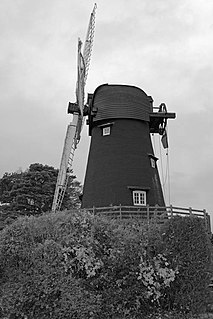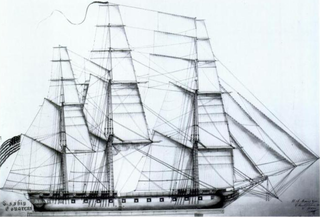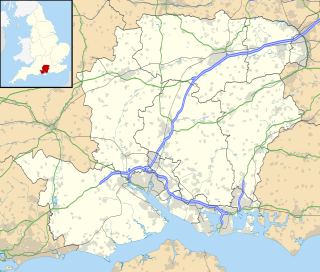Related Research Articles

The River Hamble is in south Hampshire, England. It rises near Bishop's Waltham and flows for 10.1 km (6.3 mi) through Botley, Bursledon, and Lower Swanwick before entering Southampton Water between Hamble Common and Warsash.
Mathew Baker (1530–1613) was one of the most renowned Tudor shipwrights, and the first to put the practice of shipbuilding down on paper.

Bursledon is a village on the River Hamble in Hampshire, England. It is located within the borough of Eastleigh. Close to the city of Southampton, Bursledon has a railway station, a marina, dockyards and the Bursledon Windmill. Nearby villages include Swanwick, Hamble-le-Rice, Netley and Sarisbury Green.

Warsash is a village in southern Hampshire, England, situated at the mouth of the River Hamble, west of the area known as Locks Heath. Boating plays an important part in the village's economy, and the village has a sailing club. It is also home to the Warsash Maritime Academy, part of Southampton Solent University, which provides training for Merchant Navy Officers from around the world.

George Parsons was an English shipbuilder.
John Okill was a pioneering and successful 18th century shipbuilder from Liverpool, England. Not much is known about his early life, though by the time he was 50 years old, he was a leading citizen of the town, having undertaken the roles of timber merchant and shipbuilder.

Buckler's Hard is a hamlet on the banks of the Beaulieu River in the English county of Hampshire. With its Georgian cottages running down to the river, Buckler's Hard is part of the 9,000-acre (3,600-hectare) Beaulieu Estate. The hamlet is some 2.5 miles (4.0 km) south of the village of Beaulieu.

Grace Dieu was the flagship of King Henry V of England and one of the largest ships of her time. Launched in 1418, she sailed on only one voyage and was subsequently laid up at anchor in the River Hamble. She burned in 1439 after being struck by lightning. The wreck is a Protected Wreck managed by Historic England.

Bursledon Windmill is a Grade II* listed windmill in Bursledon, Hampshire, England which has been restored to working order.
Manuel Eyre (1736–1805) was a colonel in the Continental Army, a shipbuilder, and the brother of Revolutionary War heroes Benjamin and Jehu Eyre.

Sir Anthony Deane FRS (1633–1721) was a 17th-century mayor of Harwich, naval architect, Master Shipwright and commercial shipbuilder, and Member of Parliament.

Henry Eckford was a Scottish-born American shipbuilder, naval architect, industrial engineer, and entrepreneur who worked for the United States Navy and the navy of the Ottoman Empire in the early 19th century. After building a national reputation in the United States through his shipbuilding successes during the War of 1812, he became a prominent business and political figure in New York City in the 1810s, 1820s, and early 1830s.

Bombay Dockyard—also known as Naval Dockyard—is an Indian shipbuilding yard at Mumbai. The superintendent of the dockyard is a Naval Officer of the rank Rear Admiral, known as the Admiral Superintendent.

Henry Adams (1713–1805) was a British Master Shipbuilder. He lived and worked at Bucklers Hard between 1744 and 1805. His home is now The Master Shipbuilders House Hotel in Bucklers Hard. He was responsible for building many famous warships during the late 18th and early 19th centuries.

Badger's Island is located in the Piscataqua River at Kittery, Maine, directly opposite Portsmouth, New Hampshire. It carries U.S. Route 1 between the states, connecting to the Kittery mainland by the Badger's Island Bridge, and to New Hampshire by the Memorial Bridge. Now largely a suburb of Portsmouth, the island features houses, condominiums, restaurants and marinas.

William Badger was a master shipbuilder operating in Kittery, Maine, United States who built more than 100 vessels.

James Hackett (1739–1802) was an American shipbuilder in New Hampshire in the late 18th century. He was responsible for the construction of a number of significant Revolutionary War-era warships for the fledgling country, including the Raleigh, Ranger, America, Congress, Portsmouth, two cutters for the United States Revenue Cutter Service, as well as the Crescent, built for Algiers as tribute. As a teenager, he served with Rogers' Rangers during the French and Indian War. His later military service included serving as lieutenant colonel in the New Hampshire Militia during the Revolutionary War and after in several different units.
James Havelock Harding, was a master shipwright and shipbuilder who worked at Shelburne, Nova Scotia. He was born in Queens County, Nova Scotia, Canada in 1883.

The Brickworks Museum, also known as Bursledon Brickworks, is a volunteer-run museum based in the village of Swanwick, Hampshire, England. It is thought to be the last Victorian steam-driven brickworks left in the UK.
James Robbins, died 1680, was an English shipbuilder in Danish service who built Sophia Amalia and other ships for the Danish navy.
References
- HOLLAND,A.J. Ships of British Oak: The Rise and Decline of Wooden Shipbuilding in Hampshire Newton Abbot, David & Charles. 1971.( ISBN 0715353446)
- 1750 Philemon Ewer (Master Shipbuilder) Will - Reference 'PROB 11/785'
- 1797 Philemon Ewer (Son of Master Shipbuilder) Will - Reference 'PROB 11/1287'
- There are a number of letters referring to Philemon Ewer in the 'ADM' series